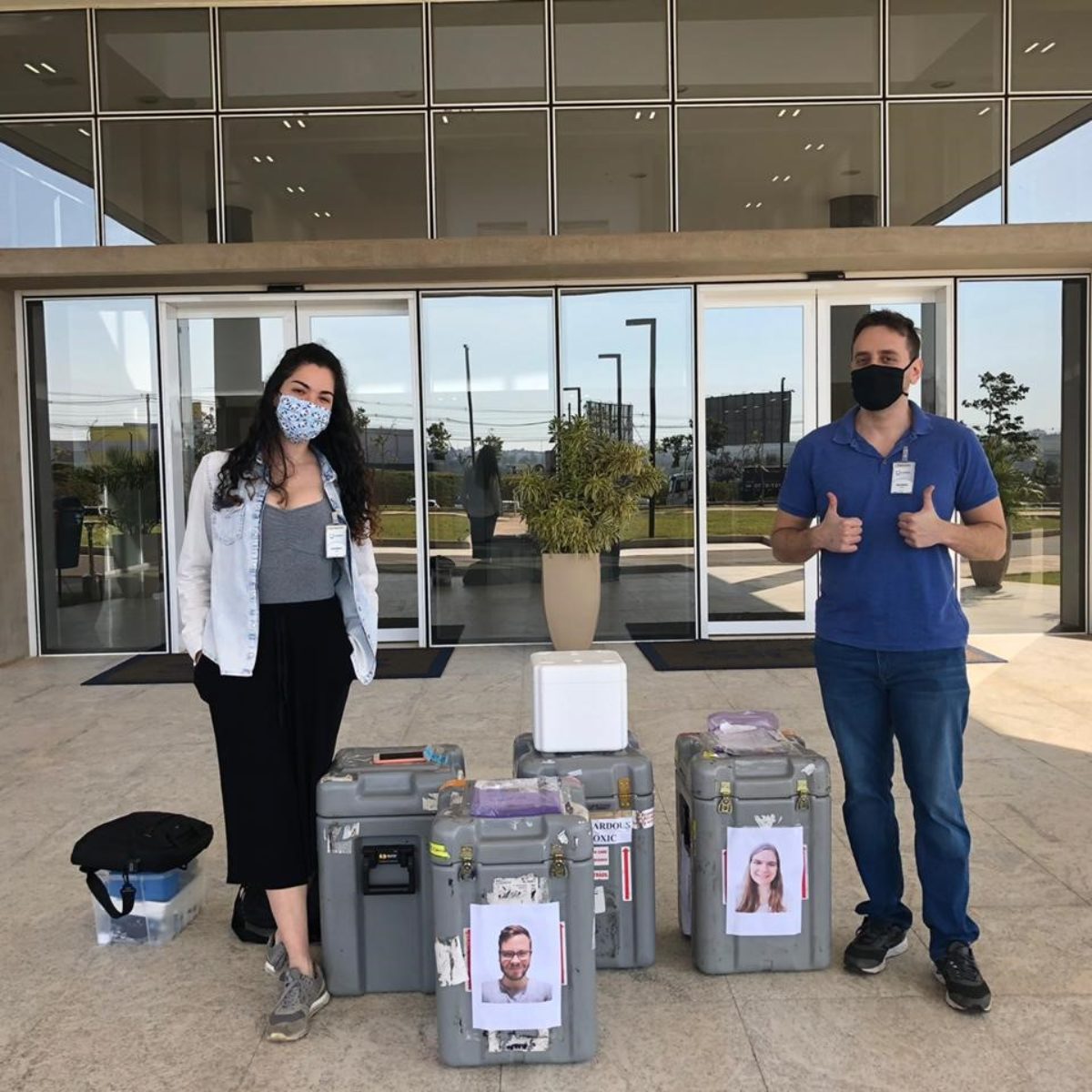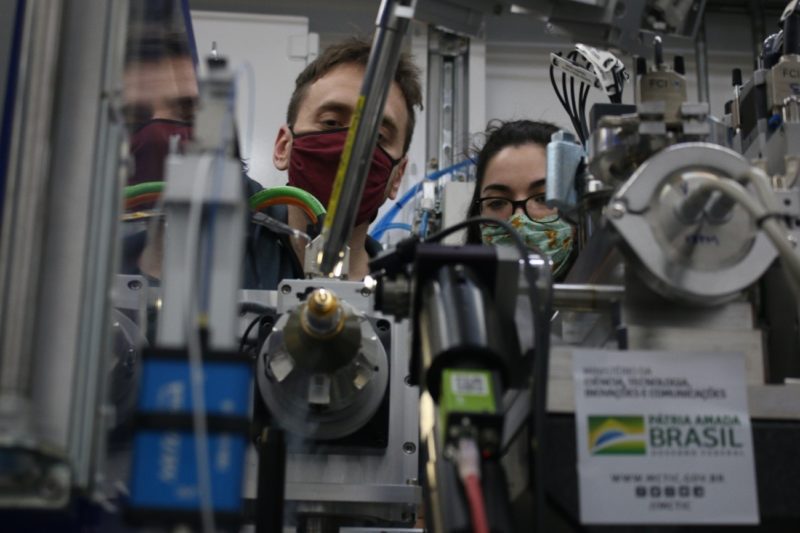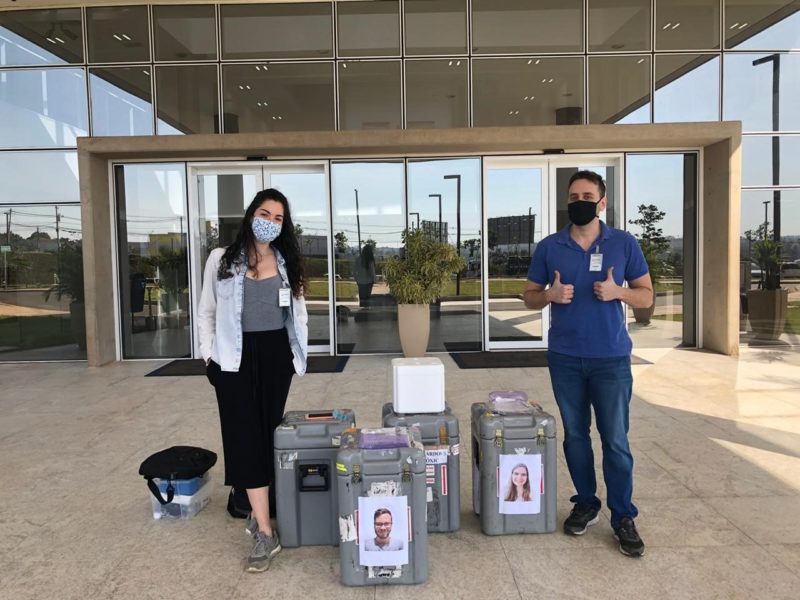
Little-understood protein from the SARS-Cov-2 virus is one of the targets of the study by researchers from USP at the synchrotron light source
In response to the pandemic, the Brazilian Center for Research in Energy and Materials (CNPEM), a private non-profit organization under the supervision of the Brazilian Ministry of Science, Technology, and Innovations (MCTI), anticipated the opening of Sirius’ first beamline to support research related to Covid-19. Researchers from the University of São Paulo (USP) were the first users of the largest and most complex scientific infrastructure in Brazil.
Two young researchers from the USP group arrived at CNPEM on September 1st. In their luggage, they brought more than 200 crystals of SARS-CoV-2 virus proteins for analysis at the Manacá beamline. Sirius will help them to elucidate the molecular structure of these proteins, which are fundamental to the virus’s life cycle, in addition to allowing the identification of molecules that bind to these proteins and can give rise to new drugs.

André Godoy and Aline Nakamura position SARS-CoV-2 protein crystal for analysis at Sirius
The researchers began their work on Covid-19 as soon as the global health emergency was announced, at the beginning of the year. Before the opening of Sirius’ first beamline, the group carried out experiments at synchrotron light sources in England and Sweden, remotely.
“We need a synchrotron light source to look for ligands that can connect to virus proteins, inhibiting their activity. In this sense, Sirius provides a “quantum leap” for the Brazilian crystallography community,” explains the research coordinator, Prof. Glaucius Oliva, one of the pioneers in the field in Brazil.
Oliva is in the city of São Carlos, as are most of his group. At Sirius, researchers André Godoy and Aline Nakamura are responsible for data collection. Although the Manacá beamline is in the so-called scientific commissioning phase, in which experiments are carried out to test the facility, the possibility of carrying out these experiments in Brazil excites the researchers.
“Sirius exceeded my expectations. Having such a machine here and carrying out analyzes of this complexity is an achievement for Brazil. What we managed to do in hours [in CNPEM’s previous synchrotron light source], now we do in minutes. This allows us to analyze a great number of samples and even to perform new techniques”, celebrates André Godoy, a researcher with ten years of experience in analysis carried out on synchrotron light sources around the world.
Sirius: the beginning of a bright future
Despite the first experiments with SARS-CoV-2, Sirius is still an ongoing project. “Manacá is the first beamline to enter into scientific commissioning, which was opened in advance in an emergency response to the pandemic. By the end of this year, the expectation is to finish the assembly of five more of Sirius’s research stations. Depending on the budgetary resources available, we should deliver 14 beamlines by the end of 2021. We are facing an important milestone in the Project by serving the first users, but there is still a lot of work to be done. Manacá itself will receive improvements, such as automation systems,” ponders Harry Westfahl Jr., Director of CNPEM’s Brazilian Synchrotron Light Laboratory (LNLS), and responsible for the development and construction of Sirius beamlines.
Although the initial phase of the project includes 14 beamlines, Sirius will house up to 38 research stations, optimized for different experiments, which can be carried out simultaneously, benefiting research in areas such as health, energy, new materials, environment, among others.
“We have a lot of work ahead of us, but each of Sirius’ steps reinforces that we have the competence to take the Brazilian science and technology to a new level. The Brazilian scientific community does a great job and we work to support it, offering unprecedented research conditions in Brazil. We are assembling a machine to be internationally competitive, designed by Brazilians and built in partnership with the national industry. We work to make Sirius a source of pride for Brazil,” says Antonio José Roque da Silva, Director-General of CNPEM and the Sirius Project.
Work during Social Distancing
At the beginning of the year, when the global public health crisis broke out, the group from USP obtained authorization to maintain activities, while most of the laboratories in the university were closed. Meanwhile, the CNPEM teams, with a reduced number of people and special working hours, rushed to make the Manacá beamline available in advance for research with SARS-Cov-2.
“Crystallizing proteins is always a big challenge. The technique requires many steps. Working in the pandemic is particularly complex. We kept four people working and they had to take on a rigorous lifestyle to dedicate themselves to research”, explains Glaucius Oliva, leader of the Center for Research and Innovation in Biodiversity and Pharmaceuticals and financed by the São Paulo Research Foundation (FAPESP) in São Carlos.
The efforts yielded results. The group obtained more than 200 crystals of virus proteins to analyze at Sirius. Upon arriving at CNPEM, the researchers scheduled to collect the data at Sirius, André Godoy and Aline Nakamura, displayed photographs of their colleagues who did not come to CNPEM on the containers used to transport the crystals.
Although they are not at CNPEM, the other members of the group have a lot of work to do. “We are sending data for them to start working on the proteins, to speed up the process,” explains Godoy.

USP researchers on arrival at Sirius display photos of colleagues who stayed in São Carlos
Fragment Screening Strategy
The objective of the first users is to reveal details of the form of non-structural proteins (NSP) of SARS-Cov-2 and to understand the mechanisms of their binding to substrates that can inhibit their activity, interfering in the virus life cycle and giving rise to new direct-acting antiviral drugs.
One of the group’s strategies is to use a technique known as ‘fragment screening’, in which high concentrations of small parts of drug molecules are used to identify, both by their shape and their chemical properties, new potential high-affinity binding points in the intricate structure of proteins.
One of the proteins studied, the viral endoribonuclease NSP-15, has functions not yet fully understood by science. One hypothesis is that it is used to circumvent the immune system of cells.
Other proteins of interest in the research are NSP-3 and NSP-5, the latter also known as the main SARS-Cov-2 protease. Both have an important role in the replication and transcription of the virus’s genetic material.
The data collected at Sirius allow researchers to identify the exact position of each atom of the protein and thus verify at which points the fragment complexes are connected. The results will support the development of new molecules that could become a new drug against COVID-19.
About Sirius
Funded by MCTI, Sirius is one of the most advanced synchrotron light sources in the world. This great scientific equipment has at its core state-of-the-art electron accelerators for generating synchrotron light, a kind of electromagnetic radiation capable of revealing the microstructure of organic and inorganic materials. These analyses are carried out at research stations called beamlines. Sirius will support several beamlines, optimized for different experiments, and that operate independently of each other, allowing different groups of researchers to work simultaneously, in different researches in a wide range of fields, such as health, energy, new materials, environment, among others.

The different experimental techniques available on Sirius’ beamlines will allow us to observe microscopic aspects of the materials, such as the atoms and molecules that constitute them, their chemical states, and their spatial organization, in addition to monitoring the evolution over time of physical, chemical and biological processes that occur in fractions of a second. In a beamline, it is also possible to follow how these microscopic characteristics change when the material is subjected to various conditions, such as high temperatures, mechanical stress, pressure, electric or magnetic fields, corrosive environments, among others. This ability is one of the main advantages of synchrotron light sources when compared to other high-resolution experimental techniques.
Sirius’ beamlines are advanced scientific instruments, designed to solve problems in strategic areas for the development of Brazil. Initially, a set of 14 beamlines is planned to cover a wide variety of scientific programs. Altogether, Sirius will be able to house up to 38 beamlines.
About CNPEM
A sophisticated and effervescent research and development environment, unique in Brazil and present in few scientific centers in the world, the Brazilian Center for Research in Energy and Materials (CNPEM) is a private non-profit organization under the supervision of the Brazilian Ministry of Science, Technology, and Innovations (MCTI).
The Center operates four National Laboratories and is the cradle of the most complex project in Brazilian science – Sirius – one of the most advanced synchrotron light sources in the world. CNPEM brings together highly specialized multi-thematic teams, globally competitive laboratory infrastructures open to the scientific community, lines of research in strategic areas, innovative projects in partnership with the productive sector, and training for researchers and students. The Center is an environment driven by the search for solutions with an impact in the areas of health, energy, environment, new materials, among others.
The unique and complementary skills present at CNPEM encourage research and development in the areas of synchrotron light; accelerator engineering; discovery of new drugs, including from plant species of Brazilian biodiversity; molecular mechanisms involved in the onset and progression of cancer, heart disease, and neurodevelopment; functionalized nanoparticles to fight bacteria, viruses, cancer; new nanostructured sensors and devices for the oil and gas, and health sectors; biotechnological solutions for the sustainable development of advanced biofuels, biochemicals, and biomaterials.
Registrations for the 30th RAU online are from August 20 to October 18, 2020.
Crystals of SARS-CoV-2 proteins were the first samples analyzed